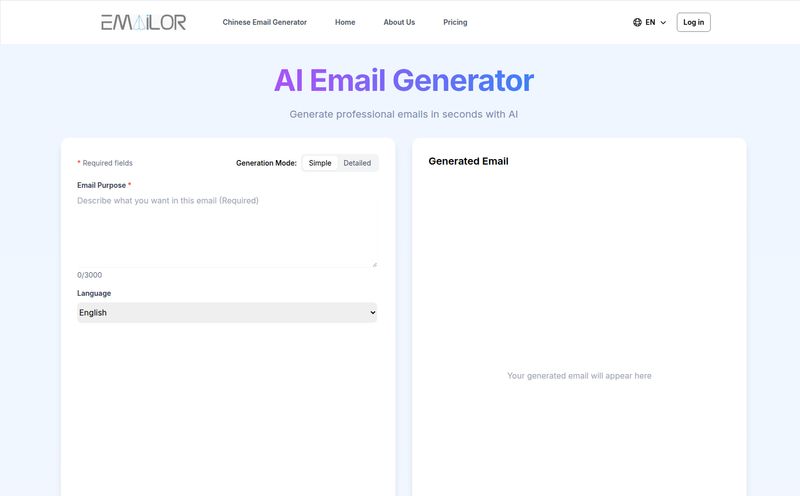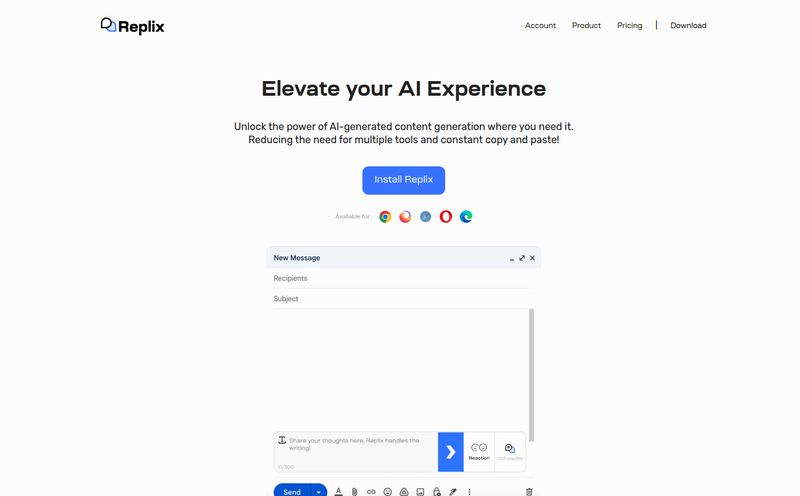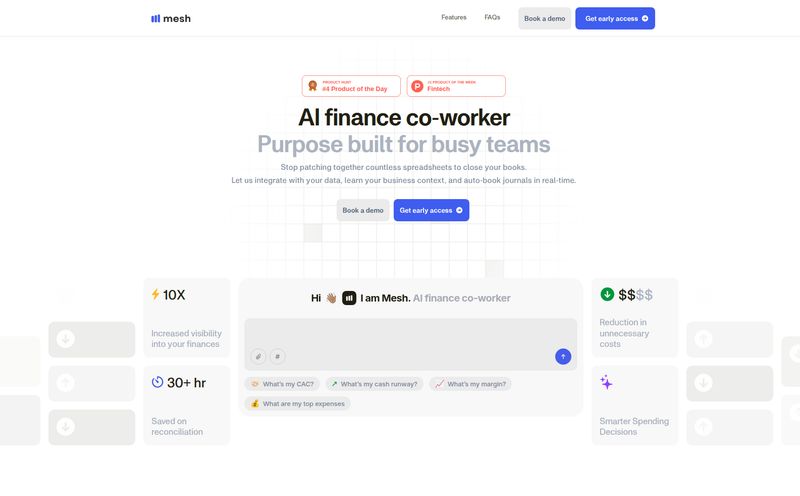If you're a freelancer, a small business owner, or just anyone who has to track expenses, you probably have a special kind of dread reserved for the end of the month. Or worse, tax season. It’s that sinking feeling when you realize you have to go on an archaeological dig through your Gmail or Outlook, searching for that one critical receipt from a client lunch nine months ago.
I’ve spent more late nights than I care to admit playing 'inbox detective,' squinting at my screen, typing keywords like “invoice,” “purchase,” and “thank you for your order” into the search bar. It’s a soul-crushing, time-sucking vortex of digital paperwork. It's the kind of busywork that makes you question all your life choices. Fun, right?
So when I heard about a tool called Receiptify, which claims to use AI to automatically find and organize all those email receipts, I was skeptical. But also… incredibly hopeful. Could this be the thing that finally tames the financial chaos living in my inbox? I had to find out.
So What Is This Receiptify Thing, Anyway?
Think of Receiptify as a tiny, hyper-organized bookkeeper that lives in your computer. Its entire job is to connect to your email inbox (it works with both Gmail and Outlook) and meticulously hunt down every single receipt hiding in there. It doesn’t just find them; it uses some pretty smart AI to read them. It pulls out all the important bits of information: the merchant's name, the total amount, the date, sales tax, and even categorizes the purchase for you. What a concept.
Instead of your inbox being a digital landfill, it helps turn it into an organized, searchable database of your spending. And it's not just for future purchases. One of its coolest tricks is its ability to go back in time, scanning your email history to pull out receipts from months, or even years, ago.
The Magic Behind Automated Receipt Management
Okay, “magic” might be a strong word, but what it does feels pretty close. The process is surprisingly simple, which is exactly what you want from a tool designed to reduce complexity.
Connecting the Dots in Your Inbox
The first step is granting Receiptify access to your inbox. Now, I know what you're thinking because I thought it too: “Is this secure?” We’ll get to that in a bit (spoiler: it is), but for now, just know that this is the key that starts the engine. Once connected, it begins its scan. It's like releasing a team of tiny robots to sort through your mail, but only for the financial stuff, leaving your personal emails untouched.
The AI Brain That Does the Heavy Lifting
This isn't just a simple keyword search. The AI is sophisticated enough to understand the structure of a receipt, no matter if it's from Amazon, Uber, or that obscure SaaS tool you subscribed to. It extracts the data and presents it in a clean, easy-to-read dashboard. No more manually typing numbers into a spreadsheet. Hallelujah. This is probably the biggest time-saver. It just eliminates that tedious data entry that's prone to human error—or in my case, 'I need more coffee' error.
What About Those Pesky Paper Receipts?
While the world is going digital, we all still end up with the occasional paper receipt from a coffee shop or a hardware store run. Receiptify thought of that. You can easily snap a picture with your phone or scan it and upload it directly to the platform. This means you can finally have all your receipts in one central hub. It's the holy grail of expense tracking!

Visit Receiptify
Key Features That Genuinely Make a Difference
A tool can have a million features, but only a few really matter in the day-to-day grind. Here are the ones in Receiptify that I think are genuine game-changers.
- QuickBooks Integration: For anyone running a business, this is huge. Receiptify can sync with your QuickBooks account, helping you match transactions and making your bookkeeping ridiculously smooth. This alone can save hours of back-and-forth with your accountant.
- Automatic Cloud Backup: Paranoia about losing data is real. Receiptify automatically backs up all your organized receipts to your own Google Drive or Dropbox. It's your data, and you get to keep a copy in your own space. I love this feature for peace of mind.
- Flexible Data Exports: Need to send everything to your accountant? Or maybe you just love a good spreadsheet (you weirdo). You can download all your receipt data in a neat ZIP file, CSV, or a combined PDF. Its' super handy for reporting.
Let’s Talk Money and The Receiptify Price Tag
Alright, this is always the big question. Is it worth the cost? Receiptify has a tiered pricing model, which I appreciate because it means you're not paying for features you don't need. Here’s a quick breakdown as I see it:
| Plan | Price | Who It's For |
|---|---|---|
| Individual | $9 /month | Perfect for solo freelancers or individuals who need to track expenses for write-offs. Manages up to 100 receipts a month from 2 inboxes. |
| Business | $29 /month | The sweet spot for most small businesses or high-volume freelancers. Unlimited inboxes, 1,000 receipts, and team member access. |
| Accountant | $79 /month | Designed for accounting firms or businesses managing multiple clients/entities. Unlimited everything, basically. |
In my opinion, the value proposition is pretty clear. If you calculate your hourly rate, and then figure out how many hours you spend hunting for receipts… the $9 or $29 a month starts to look like a bargain. Seriously.
My Final, Honest Take on Receiptify
So, is Receiptify the magic bullet for all your expense-tracking woes? It's pretty darn close. It excels at what it promises: automating the infuriating process of finding and organizing digital receipts. The time it saves is its most significant benefit.
While no cons were immediately obvious, one could argue that it's another subscription in a world full of them. But I’d argue this one pays for itself. The only thing it can't do is stop you from spending money in the first place, but hey, maybe that's in a future update.
For freelancers, small business owners, and bookkeepers, this tool isn't just a 'nice-to-have.' It’s a sanity-saver. It takes one of the most tedious parts of running a business and puts it on autopilot. And for that, I am eternally grateful.
Frequently Asked Questions
- Can Receiptify find receipts from a long time ago?
- Yes! Depending on your plan, it can go back 12 months or even up to 4 years to analyze past emails and pull out all the receipts it finds. It's fantastic for getting caught up.
- What if I have a paper receipt?
- No problem. Receiptify has a manual upload feature, so you can just take a picture of your paper receipt with your phone and add it to your account. This keeps everything in one unified place.
- Is it secure to connect my email to Receiptify?
- This is a valid concern. Receiptify takes security seriously and states they have passed a CASA TIER 2 assessment. This is a robust security validation that means your data is handled with a high level of protection and privacy in mind.
- Can I export my receipts for my accountant?
- Absolutely. You can download comprehensive reports of your receipts in multiple formats, including ZIP, CSV, or PDF, making it super easy to share with your accountant or for your own records.
- Does it work with anything besides Gmail and Outlook?
- Currently, its main integrations are with Gmail and Outlook, which cover a huge majority of users. You'd have to check their site for any new email providers they might add in the future.
Conclusion
At the end of the day, we're all looking for ways to get time back in our day. We want to spend less time on mind-numbing admin tasks and more time on the work that actually matters (or, you know, just not working). Receiptify is a powerful ally in that fight. It tackles the specific, universal pain point of receipt management with an elegant and effective solution. If your inbox looks anything like my old receipt graveyard, I’d say it’s well worth a look.



